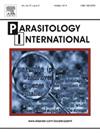Morphological and molecular characterization of Myxobolus aculeatus n. sp. (Myxozoa: Myxosporea) from the ovary of Macrognathus aculeatus, Bloch, 1786 (Synbranchiformes: Mastacembelidae) in China
IF 1.9
4区 医学
Q3 PARASITOLOGY
引用次数: 0
Abstract
Macrognathus aculeatus is a commercially significant cultured fish in China. However, prior to this study, there had been minimal attention directed towards its myxosporean infection. The present study has identified a previously unrecorded species of Myxobolus found in the ovary of M. aculeatus. The mature spores were elliptical in the frontal view, and fusiform in the sutural view, measuring 13.0 ± 0.2 (11.5–14) μm in length, 6.4 ± 0.3 (6.0–7.2) μm in width, and 5.3 ± 0.2 (4.9–5.6) μm in thickness. The two equal polar capsules were pyriform, with a length of 4.5 ± 0.2 (3.5–4.7) μm and a width of 2.4 ± 0.1 (2.3–2.6) μm, and contained 5–6 polar filament coils. A rigorous morphological comparison revealed that the current species exhibited notable distinctions from the previously documented congeners. Histopathological analysis indicated that the parasite resided between oocytes, yet no discernible host inflammatory response was observed. A comparison of the SSU rDNA gene sequences revealed that the present species exhibited the highest degree of similarity to Myxobolus parasites found in the gills of Tachysurus fulvidraco, with a sequence similarity of 86.54 %. Further phylogenetic analysis demonstrated that the current species exhibited a clustering pattern with several myxobolids infecting Tachysurus (Siluriformes), yet displayed a distinct positioning. The Myxobolus species in question represents a new scientific discovery and has been designated as Myxobolus aculeatus n. sp. on the basis of an integrated analysis of morphological, histopathological and molecular data.

1786年Bloch, Macrognathus aculeatus n. sp.(粘虫目:粘孢子目)的形态和分子特征(合枝目:Mastacembelidae
在中国,粗颌鱼是一种具有重要商业价值的养殖鱼类。然而,在这项研究之前,很少有人关注其粘孢子菌感染。本研究鉴定了一种以前未记录的粘虫,发现于M. aculeatus的卵巢。成熟孢子正面观呈椭圆形,针孔观呈梭形,长13.0±0.2 (11.5-14)μm,宽6.4±0.3 (6.0-7.2)μm,厚5.3±0.2 (4.9-5.6)μm。两个极性相等的胶囊为梨形,长4.5±0.2 (3.5-4.7)μm,宽2.4±0.1 (2.3-2.6)μm,包含5-6个极性灯丝线圈。严格的形态学比较表明,现在的物种与以前记录的同系物有显著的区别。组织病理学分析表明,寄生虫驻留在卵母细胞之间,但没有观察到明显的宿主炎症反应。结果表明,该物种与黄颡鱼(Tachysurus fulvidraco)鳃中黏液虫(Myxobolus)的相似度最高,为86.54%。进一步的系统发育分析表明,目前的物种呈现出一种聚类模式,与几个黏液体感染Tachysurus (Siluriformes),但显示出不同的定位。根据形态学、组织病理学和分子病理学的综合分析,该物种被命名为Myxobolus aculeatus n. sp.。
本文章由计算机程序翻译,如有差异,请以英文原文为准。
求助全文
约1分钟内获得全文
求助全文
来源期刊

Parasitology International
医学-寄生虫学
CiteScore
4.00
自引率
10.50%
发文量
140
审稿时长
61 days
期刊介绍:
Parasitology International provides a medium for rapid, carefully reviewed publications in the field of human and animal parasitology. Original papers, rapid communications, and original case reports from all geographical areas and covering all parasitological disciplines, including structure, immunology, cell biology, biochemistry, molecular biology, and systematics, may be submitted. Reviews on recent developments are invited regularly, but suggestions in this respect are welcome. Letters to the Editor commenting on any aspect of the Journal are also welcome.
 求助内容:
求助内容: 应助结果提醒方式:
应助结果提醒方式:


